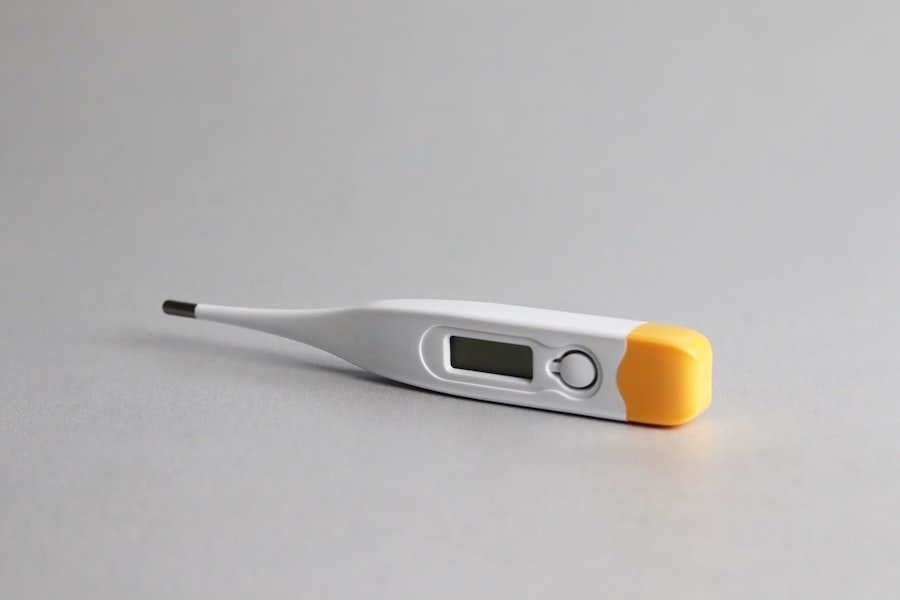The iPhone, a flagship product of Apple Inc., is renowned for its cutting-edge technology and innovative features. Among these features is the ability to monitor and regulate temperature, which plays a crucial role in maintaining the device’s performance and longevity. The temperature sensor in an iPhone is not just a simple component; it is an integral part of the device’s overall functionality, ensuring that the internal components operate within safe temperature ranges.
This capability is essential for preventing overheating, which can lead to hardware malfunctions or reduced battery life. Understanding the intricacies of the iPhone’s temperature sensor involves delving into how it functions, its limitations, and its applications. While many users may not be aware of the specifics, the temperature sensor contributes significantly to the user experience by ensuring that the device remains responsive and efficient.
As smartphones become increasingly sophisticated, the role of temperature regulation becomes even more critical, making it a topic worth exploring in detail.
Key Takeaways
- The iPhone has a built-in temperature sensor that helps regulate its internal temperature and prevent overheating.
- The iPhone uses a combination of hardware and software to regulate its temperature, including adjusting performance and shutting down certain features if it gets too hot.
- The iPhone can detect external temperature to some extent, but it primarily focuses on regulating its own internal temperature.
- Yes, the iPhone has a built-in temperature sensor that helps monitor its internal temperature and make adjustments as needed.
- Users can check the temperature on their iPhone using various apps and features, such as the Weather app or third-party temperature sensor apps.
How does the iPhone regulate temperature?
Dynamic Response to Temperature Changes
For instance, if the processor begins to overheat during intensive tasks like gaming or video rendering, the iPhone can automatically throttle performance to reduce heat generation.
Intelligent Resource Management
On the software side, Apple’s iOS operating system plays a pivotal role in temperature regulation. The system is designed to manage resource allocation intelligently, ensuring that demanding applications do not run simultaneously unless necessary. This resource management helps prevent excessive heat buildup.
Safety Protocols and User Alerts
Additionally, iOS includes built-in safety protocols that trigger alerts when the device reaches critical temperatures. Users may receive notifications indicating that their iPhone needs to cool down, prompting them to take action, such as moving it to a cooler environment or ceasing resource-intensive activities.
Can the iPhone detect external temperature?

While the iPhone is equipped with internal temperature sensors to monitor its own components, it does not have a dedicated external temperature sensor for measuring ambient temperatures. This limitation means that users cannot directly use their iPhones to gauge the weather or environmental conditions outside. However, there are alternative methods for obtaining external temperature readings through third-party applications and accessories.
Some apps utilize data from online weather services to provide users with real-time temperature information based on their location. These applications rely on GPS and internet connectivity to access weather data rather than measuring external temperatures directly. Additionally, there are external devices available that can connect to an iPhone via Bluetooth or other means, allowing users to measure ambient temperatures accurately.
These devices often come with their own sensors and can provide detailed readings that an iPhone alone cannot offer.
Does the iPhone have a built-in temperature sensor?
| iPhone Model | Temperature Sensor |
|---|---|
| iPhone 3G | No |
| iPhone 4 | Yes |
| iPhone 5 | Yes |
| iPhone 6 | Yes |
| iPhone 7 | Yes |
| iPhone 8 | Yes |
| iPhone X | Yes |
| iPhone 11 | Yes |
| iPhone 12 | Yes |
The iPhone does not feature a dedicated built-in temperature sensor for measuring external temperatures; however, it does include internal sensors designed to monitor the device’s thermal state. These sensors are crucial for ensuring that the iPhone operates within safe temperature limits. The internal sensors track the temperatures of various components, including the CPU, GPU, and battery, providing real-time data that informs the device’s performance management systems.
The absence of an external temperature sensor may seem like a drawback for users seeking comprehensive environmental data. Still, Apple’s design philosophy prioritizes user experience and device integrity over adding features that may not align with their core functionality. By focusing on internal temperature regulation, Apple ensures that users enjoy a reliable and efficient device while minimizing risks associated with overheating.
How to check the temperature on an iPhone
While users cannot directly check the ambient temperature using their iPhones due to the lack of an external sensor, they can monitor the internal temperatures of their devices indirectly through various means. One common method is by observing performance-related notifications from iOS. If an iPhone becomes too hot during use, users may receive alerts indicating that they should allow their device to cool down before continuing to use it.
For those interested in more technical insights into their device’s performance, third-party applications can provide detailed information about CPU and battery temperatures. Apps like CPU-X or Lirum Device Info can display real-time data about various hardware metrics, including thermal readings. These applications tap into system APIs to extract information about internal temperatures, giving users a glimpse into how their device is managing heat during intensive tasks.
Limitations of the iPhone temperature sensor

Despite its advanced technology, the iPhone’s temperature sensing capabilities come with inherent limitations. One significant limitation is its inability to measure external temperatures directly. Users seeking accurate ambient temperature readings must rely on third-party applications or external devices, which may not always provide precise data due to variations in measurement techniques or environmental factors.
Another limitation lies in the range of temperatures that the internal sensors can accurately monitor. While they are effective at detecting overheating conditions and managing performance accordingly, they may not provide detailed insights into minor fluctuations in temperature during regular use. This lack of granularity can be frustrating for users who want more comprehensive data about their device’s thermal state.
Additionally, while Apple’s software optimizations help manage heat effectively, there are scenarios where excessive heat can still impact performance. For example, prolonged exposure to high temperatures can lead to battery degradation over time, affecting overall battery life and efficiency. Users must be mindful of their device’s operating environment and avoid exposing it to extreme conditions that could compromise its performance.
Other devices with temperature sensors
Temperature sensors are ubiquitous in modern technology beyond smartphones like the iPhone. Many consumer electronics incorporate these sensors for various purposes, enhancing user experience and safety. For instance, smart thermostats such as the Nest Learning Thermostat utilize advanced temperature sensors to monitor home environments and adjust heating or cooling systems accordingly.
These devices learn user preferences over time and optimize energy consumption based on real-time data. Wearable technology also features integrated temperature sensors for health monitoring purposes. Fitness trackers and smartwatches often include sensors that measure skin temperature as part of their health metrics.
This data can provide insights into a user’s physical condition and help detect potential health issues early on. In industrial applications, temperature sensors play a critical role in monitoring equipment performance and ensuring safety in manufacturing processes. Thermocouples and infrared sensors are commonly used in various industries to track temperatures in machinery and production lines, preventing overheating and equipment failure.
Future developments in iPhone temperature sensing technology
As technology continues to evolve rapidly, future developments in iPhone temperature sensing technology may lead to more sophisticated capabilities. One potential advancement could involve integrating external temperature sensors directly into future iPhone models. Such a feature would allow users to measure ambient temperatures accurately without relying on third-party devices or applications.
Moreover, advancements in sensor technology could enable more precise monitoring of internal temperatures across various components within the device. Enhanced thermal management systems could be developed to optimize performance dynamically based on real-time thermal data, further improving user experience during demanding tasks. Additionally, as Apple continues to invest in health-related technologies, there may be opportunities for integrating health monitoring features related to body temperature into future iPhones.
This could align with broader trends in health tech and wellness applications, providing users with valuable insights into their physical well-being. In conclusion, while the current state of iPhone temperature sensing technology has its limitations, ongoing advancements in this field hold promise for enhancing user experience and device performance in future iterations of Apple’s flagship smartphone.
According to a recent article on getiphoneinfo.com, the iPhone does not have a built-in temperature sensor. This means that the device is unable to accurately measure the temperature of its surroundings. However, there are third-party accessories and apps available that can provide temperature readings for iPhone users. For more information on iPhone features and capabilities, be sure to check out the website’s terms and conditions and privacy policy.
FAQs
What is a temperature sensor?
A temperature sensor is a device that measures the temperature of its environment and converts the input data into an output signal.
Does the iPhone have a temperature sensor?
Yes, the iPhone has a built-in temperature sensor that is used to monitor the device’s internal temperature.
How does the iPhone temperature sensor work?
The iPhone temperature sensor is integrated into the device’s hardware and is designed to monitor the internal temperature of the device. It helps to prevent overheating and regulates the device’s performance accordingly.
Can the iPhone temperature sensor be accessed by users?
The iPhone temperature sensor is not directly accessible to users through the device’s settings or apps. It is primarily used by the device’s operating system to manage the device’s temperature and performance.
What are the implications of the iPhone having a temperature sensor?
The presence of a temperature sensor in the iPhone allows the device to regulate its performance and prevent overheating, which can help maintain the device’s functionality and prolong its lifespan.










